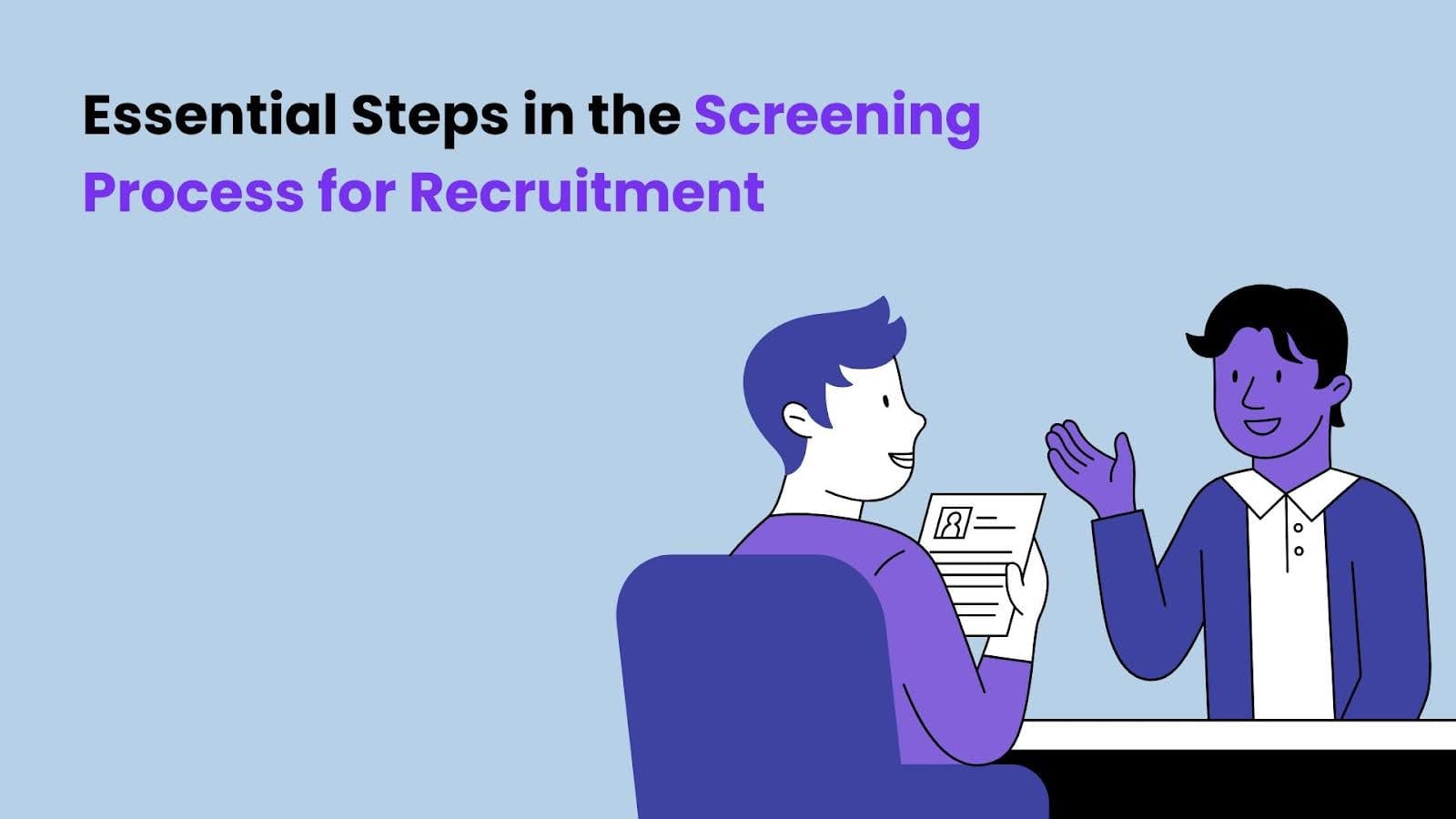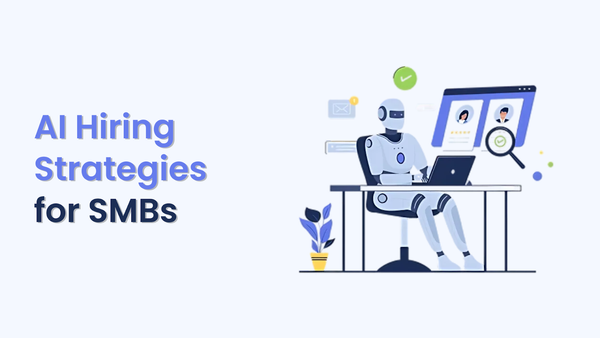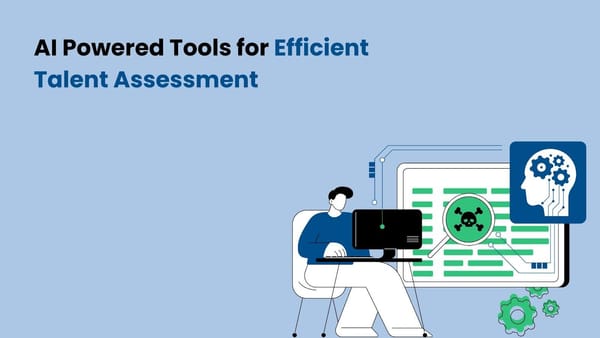How do you turn a flood of applications into the perfect hire without wasting time or resources?
Screening in recruitment is the process of sorting through applications to find candidates who meet the requirements for a job. It helps employers identify the best matches from a large pool of applicants, making it a crucial part of the hiring process. An effective screening process not only saves time and effort but also ensures you hire the right people for your team. It’s the first step toward building a capable and successful workforce.
In this blog, we’ll break down the key steps of the screening process, why it’s so important, and how you can improve your approach to find the best candidates quickly and efficiently.
Before looking into the steps involved, it’s important to clarify what candidate screening actually means.
What is Candidate Screening?
Candidate screening in recruitment refers to the process of reviewing job applicants' qualifications, experience, skills, and other factors to assess whether they match the requirements for a job. Screening helps hiring teams filter out unqualified applicants and shortlist those who best meet the criteria.
This process can take various forms, such as reviewing resumes, conducting initial phone interviews, and checking references or background. The ultimate goal is to ensure that the company selects candidates who align with the organization’s needs, values, and culture.
Screening is not just about rejecting unsuitable candidates but also about ensuring that you find the right person who will contribute positively to the company’s goals.
Now that we’ve established what candidate screening is, let’s look at how to prepare for the screening process.
Preparation for Screening
The effectiveness of the screening process depends on how well the hiring team prepares for it. A solid foundation makes the process smoother and more effective. Here are some key preparation steps for effective screening:
- Define Job Requirements ClearlyBefore you start screening candidates, you must first have a clear understanding of the job requirements. This means working with hiring managers to define the essential skills, experience, and qualifications for the role. For example, if you're hiring for a marketing role, you might prioritize candidates with digital marketing expertise and proven experience in running successful campaigns.
- Prepare Job DescriptionsA well-written job description is crucial for setting the right expectations for applicants. A good description should outline the responsibilities of the role, the skills and qualifications required, and any specific competencies the company values. This also helps candidates assess whether the position aligns with their skills and career aspirations.
- Create a Screening ChecklistHaving a screening checklist ensures that you don’t miss any crucial aspects when evaluating candidates. The checklist could include factors like relevant experience, educational qualifications, technical skills, and even cultural fit. This structured approach helps keep the process consistent and objective.
- Train Your Screening TeamScreening candidates is often done by a team of recruiters, and it’s essential that they are all aligned in their understanding of the job requirements and the ideal candidate. Training your team on how to assess resumes, conduct initial interviews, and evaluate soft skills will ensure the screening process is thorough and unbiased.
With adequate preparation in place, you are ready to start the screening process. But what exactly are the key steps involved? Let’s take a look.
Steps in the Screening Process
The screening process involves several steps to assess whether an applicant is a good fit for the role. Each step builds on the previous one, ensuring that no stone is left unturned. Here’s a breakdown of the steps involved in a typical recruitment screening process:
Resume Review
The first step in candidate screening is to review the resumes or CVs of the applicants. This step is designed to identify if the candidate meets the basic qualifications and experience needed for the role. During this phase, you should look for:
- Relevant work experience
- Education and certifications
- Skills and competencies
- Achievements and accomplishments
Resumes are the first impression a candidate makes, so it’s crucial to look at them carefully to spot any red flags such as unexplained gaps in employment or frequent job changes.
Initial Screening Call
Once you've shortlisted candidates based on their resumes, the next step is often a phone interview or an initial screening call. This is a relatively informal conversation where you can ask about the candidate’s background, motivations, and their understanding of the role. This step serves multiple purposes:
- Verifying the information on the resume
- Assessing communication skills
- Understanding the candidate's interest in the role
- Gauging cultural fit
A well-conducted screening call can help you quickly weed out candidates who aren’t a good fit before moving them to the next round.
Skill Assessments or Tests
For roles that require specific technical skills or knowledge, an assessment test is often necessary. These tests can take various forms, from coding challenges for software developers to writing assignments for content writers. Skill assessments help hiring teams objectively measure candidates' capabilities and determine whether they have the expertise needed for the job.
In-Depth Interviews
Once candidates pass the initial screening and assessment phase, the next step is a more comprehensive interview. In this stage, candidates meet with the hiring manager or a panel of interviewers to explore their qualifications, skills, and experience. This is a chance to ask behavioral questions that assess problem-solving abilities, teamwork, and .
Some key things to focus on during the in-depth interview include:
- The candidate’s past experiences and achievements
- Their approach to handling challenges or conflicts
- Their ability to work in a team or independently
- Their long-term career aspirations
Behavioral interview techniques, where you ask candidates to share specific examples from their previous work experience, can be very helpful during this stage.
Reference Checks
After interviews, it’s crucial to verify the information the candidate provided. This is where reference checks come into play. Contacting a candidate’s previous employers, colleagues, or mentors can give you deeper insight into their work ethic, character, and performance. A reference check can either confirm your initial impressions or raise new questions that need further investigation.
Background Checks
Background checks are a final step in the screening process, particularly for roles that require high levels of trust, such as in finance, healthcare, or senior management. This can involve criminal background checks, credit checks, or verification of educational qualifications. Conducting thorough background checks ensures that candidates are who they say they are and can be trusted with sensitive responsibilities.
Now that we’ve explored the key steps in the screening process, let’s take a look at the tools and technologies that can enhance this process.
Tools and Technologies in Screening
The screening process has evolved considerably with the advent of technology. Today, recruitment teams have a variety of tools and software at their disposal to streamline and improve the screening process. Here are some of the most commonly used tools in modern recruitment screening:
AI-driven recruitment platform: TidyHire
Tidyhire enhances candidate screening through its AI-powered Recruiting Intelligence Agent (RIA), which automates and refines the hiring process. Key features include:
- Automated Candidate Sourcing: RIA accesses over 700 million professional profiles, sourcing verified candidates from over 30 platforms, and delivering suitable candidates directly to your inbox.
- AI-Driven Screening: Tidyhire's AI analyzes resumes and applications, ranking candidates based on predefined criteria to provide you with a ready-to-review shortlist.
- Personalized Outreach and Follow-ups: RIA crafts tailored messages and manages follow-up communications, ensuring candidates remain engaged throughout the hiring process.
By automating these aspects, Tidyhire reduces manual workload, accelerates the screening process, and efficiently helps identify the most suitable candidates.
Applicant Tracking Systems (ATS):
An ATS software application automates much of the recruitment process, including screening resumes. It helps recruiters quickly filter through large volumes of applications by scanning for keywords, qualifications, and experience relevant to the job posting. ATS systems can save considerable time and effort in the initial stages of the screening process.
Video Interviewing Software
Video interviewing tools such as Zoom, Microsoft Teams, or specialized platforms like HireVue allow for efficient remote interviews. These tools are particularly useful for initial or in-depth interviews when face-to-face meetings are not possible. They often come with features such as AI-driven analysis of candidate responses and automated scheduling, making the process more efficient.
Skill Assessment Platforms
Platforms like Codility or HackerRank provide online coding tests and challenges, helping you assess a candidate’s technical skills. For non-technical roles, tools like Grammarly or ProveIt can assess writing skills, grammar, and language proficiency.
These tools significantly improve the speed and accuracy of the screening process, helping hiring teams make better decisions with fewer resources.
In addition to using the right tools, following best practices ensures that the screening process remains effective and efficient.
Best Practices for Effective Screening
For the screening process to be successful, it's important to follow certain best practices that ensure fairness, efficiency, and accuracy. Here are some tips to keep in mind:
- Standardize the Process: To reduce bias and ensure consistency, create a standardized process for evaluating all candidates. This includes using a consistent checklist or scoring system, asking the same core questions in interviews, and reviewing each resume against the same criteria.
- Avoid Bias: It’s easy for unconscious biases to creep into the screening process. Whether it’s based on gender, age, ethnicity, or even education level, biases can lead to unfair decisions. Be aware of these biases and try to evaluate candidates solely on their qualifications and experience.
- Communicate Clearly: Throughout the screening process, maintain clear and open communication with candidates. Let them know what to expect at each stage and provide feedback when necessary. Clear communication helps set expectations and fosters a positive candidate experience.
- Be Transparent: Transparency is key to building trust with candidates. If a candidate is not selected, it’s good practice to let them know the reasons why. This feedback can help candidates improve for future opportunities and can leave them with a positive impression of your company.
Conclusion
The screening process in recruitment is a critical step in identifying the most suitable candidates for a role. By effectively evaluating resumes, qualifications, and compatibility with organizational needs, screening ensures that only the best candidates move forward in the hiring process. Leveraging advanced tools and strategies can significantly improve the efficiency and accuracy of this step, saving time and resources while fostering better hiring outcomes.
Tidyhire simplifies and enhances the screening process with its AI-powered Recruiting Intelligence Agent (RIA). It automates tasks like candidate sourcing, resume analysis, and communication, ensuring that recruiters can focus on high-value interactions. With tools designed to rank candidates based on criteria and manage follow-ups seamlessly, Tidyhire accelerates the recruitment workflow and ensures you identify top talent with ease.
Ready to revolutionize your recruitment process? Discover how Tidyhire can transform your candidate screening and hiring strategies. Book a call with us today to learn more and start building a smarter, more efficient hiring pipeline!



